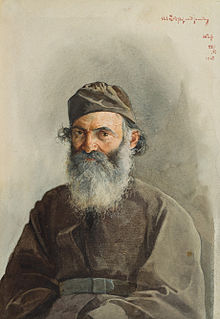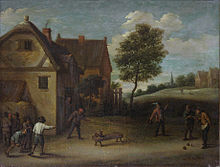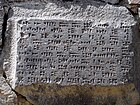National Gallery of Armenia
Հայաստանի ազգային պատկերասրահ | |
 The National Gallery of Armenia in Yerevan | |
 | |
| Established | 1921 |
|---|---|
| Location | Yerevan, Armenia |
| Type | art gallery |
| Visitors | 65,000 (2005) |
| Director | Arman Tsaturyan |
| Website | official website |
The National Gallery of Armenia (Template:Lang-hy) is the largest art museum in the Republic of Armenia. Located on Yerevan's Republic Square, the museum has one of the most prominent locations in the Armenian capital. The NPGA houses significant collections of Russian and Western European art, and the world's largest collection of Armenian art. The museum had 65,000 visitors in 2005.[1]
History
The National Gallery of Armenia (NGA) was founded in 1921 under the decree of the Armenian Soviet Socialist Republic (Armenian SSR) and represents the artistic section of the State museum. Upon its establishment the NGA's art section encountered difficulties, largely because Yerevan lacked state owned and private art collections to form the core of the collection. The first works to enter the collection where the dozens of works purchased from an Armenian painters' exhibition in August 1921.
A decisive factor in the founding of the NGA's art collection was the transfer of the renowned collection of The Armenian Cultural Center (the former Lazarian Seminary, Moscow) and also the donations made by Armenian artists to the NGA. By 1925, 400 pieces by Armenian, Russian and European artists were on display throughout the six halls which compose the museum's art section.
By 1935, the state art section, which had undergone many refurbishments, became a separate Art Museum. In 1947 the gallery was re-dubbed the State Picture Gallery of Armenia and subsequently renamed the National Gallery of Armenia in 1991. The picture gallery's large collection of works are on display thanks to the efforts of many dedicated compatriots and friendly donations from foreign associates.
The NGA currently houses around 26,000 works of art, many of which are permanently displayed in the museum's 56 galleries and halls.
Description


Armenian art makes up a large part of the collection, beginning with ancient and Medieval art: Urartu frescoes and copies of Garni Temple’s mosaics and Medieval wall-paintings and miniatures, including a 7th-century fresco of "Christ Enthroned" from St. Stephanos Church (Lmbatavank), a10th-century fresco fragment of "The Last Judgment" from St. Poghos-Petros (Tatev), and a 13th-century fresco depicting the Nativity from St. Astvatsatskin (Akhtala),
The museum has an extensive collection of Armenian Apostolic Church-related paintings ranging from the 17th-19th centuries, as well as, silver book-covers of manuscripts, crosses, and 18th-century altar curtains from across Asia.
The collection of historic Armenian art is the largest in the world. There are particularly strong collections of work by Hakob Hovnatanyan, Hovhannes Aivazovsky, Gevorg Bashinjaghian, Panos Terlemezian, Vardges Sureniants, Vartan Mahokian, Martiros Saryan, Hakob Kojoyan, Hakob Gyurjian, Edgar Chahine, G. Khanjian, Minas Avetisyan, and many more.
There is a particular strength in the field of art by diasporan Armenians, and it includes works by Zakar Zakarian (Paris), Edgar Chahine (Paris), Hovsep Pushman (New York), Jean Carzou (Paris), Jean Jansem (Paris), Gerardo Oragyan (Rome), and Paul Guiragossian (Beirut).[2]
Russian art is also extensively present in the NPGA's collection. These include religious icons and images from the 16th and 17th centuries and works of well-known Russian artists from the 18th–20th-century, including F. Rokotov, I. Argunov, F. Shubin, Ilya Repin, Valentin Serov, Ilya Mashkov, Sergey Konenkov, Kuzma Petrov-Vodkin, Vassily Kandinsky, Natalia Goncharova, Marc Chagall, and others.
NPGA has also incorporated many examples of "foreign art" (predominantly Western) into their collection, many of which were originally part of the 'Armenian Cultural Center' (the former Lazarian Seminary, Moscow), which was nationalized during the Soviet period and moved to Yerevan.
The ancient collections include examples of ancient art from Egypt (New Kingdom, Greco-Roman, Coptic), Greece (Corinth, Attica), Rome, and Iran. The Decorative Arts department has ceramic and porcelain collections of Chinese, Iranian, Italian, Japan, German, Austrian, Danish, and an extensive collection from the 18th–19th-century Tsarist Imperial Porcelain Factory in Russia. There are also a small collection of bronze items from 18th-century China (Qing dynasty) and 16th–17th-century Western European wooden furniture.
There are a number of European Old Master works in their holdings, including works by well-known artists from Italy, Holland, Belgium and French art movements, including significant works by Donatello, Tintoretto, Antonio Canova, Joos de Momper, Caspar Netscher, Matthias Stomer, Jan Van Goyen, P. Claesz, E. M. Falconet, Carle Vanloo, J. B. Greuze, Joseph Vernet, Robert Hubert, Théodore Rousseau, Adolphe Monticelli.[3]
In 2008, a pavilion was opened specifically for Hakob Gurjian’s works.
The NPGA building also houses the restoration and conservation studios affiliated with the museum. The complex also has a moderately sized library and archive, a small cafeteria, a souvenir and book store, and a hall used for film screenings and lectures.
The NPGA also lends to international exhibitions with works from her collection, helping to organizize exhibitions of Armenian art in different countries to see that Armenia's works are appreciated by citizens around the world.
Gallery Directors
In the years prior the gallery was directed by:[4]
- Arman Tsaturyan (2015)[5]
- Pharaon Mirzoyan (2002–2015)
- Shahen Khachatryan (1991-2002)
- Alexandr Ter-Gabrielyan (1987-1990)
- Eduard Isabekyan (1967-1987)
- Armen Chilingaryan (1962-1967)
- Ruben Parsamyan (1952-1962)
- Ruben Drampyan (1925-1951)
See also
- Lydia Durnovo, art historian and restorer
References
- ^ "Arts Digest - Arts and Culture - ArmeniaNow.com". armenianow.com.
- ^ National Gallery of Armenia: Painting, Graphics, Sculpture, Applied Art (Yerevan: Tigran Mets Publishing, 2008)
- ^ National Gallery of Armenia: Painting, Graphics, Sculpture, Applied Art (Yerevan: Tigran Mets Publishing, 2008)
- ^ [1][dead link]
- ^ Biography of Arman Tsaturyan at the web page of National Gallery of Armenia

